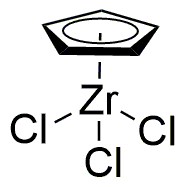Cyclopentadienylzirconium(IV) trichloride is widely utilized in research focused on:
- Catalysis: This compound serves as a catalyst in various organic reactions, particularly in polymerization processes, enhancing reaction efficiency and product yield.
- Materials Science: It is used in the development of advanced materials, including high-performance polymers and composites, which are essential in industries like aerospace and automotive.
- Organometallic Chemistry: Researchers employ it to synthesize new organometallic compounds, expanding the toolkit for creating novel chemical entities with unique properties.
- Pharmaceutical Development: Its role in drug synthesis can lead to the creation of more effective pharmaceutical agents, addressing specific medical needs with improved efficacy.
- Environmental Applications: The compound is also explored for its potential in catalyzing reactions that reduce environmental pollutants, contributing to greener chemistry practices.
General Information
Properties
Safety and Regulations
Applications
Cyclopentadienylzirconium(IV) trichloride is widely utilized in research focused on:
- Catalysis: This compound serves as a catalyst in various organic reactions, particularly in polymerization processes, enhancing reaction efficiency and product yield.
- Materials Science: It is used in the development of advanced materials, including high-performance polymers and composites, which are essential in industries like aerospace and automotive.
- Organometallic Chemistry: Researchers employ it to synthesize new organometallic compounds, expanding the toolkit for creating novel chemical entities with unique properties.
- Pharmaceutical Development: Its role in drug synthesis can lead to the creation of more effective pharmaceutical agents, addressing specific medical needs with improved efficacy.
- Environmental Applications: The compound is also explored for its potential in catalyzing reactions that reduce environmental pollutants, contributing to greener chemistry practices.
Documents
Safety Data Sheets (SDS)
The SDS provides comprehensive safety information on handling, storage, and disposal of the product.
Product Specification (PS)
The PS provides a comprehensive breakdown of the product’s properties, including chemical composition, physical state, purity, and storage requirements. It also details acceptable quality ranges and the product's intended applications.
Certificates of Analysis (COA)
Search for Certificates of Analysis (COA) by entering the products Lot Number. Lot and Batch Numbers can be found on a product’s label following the words ‘Lot’ or ‘Batch’.
*Catalog Number
*Lot Number
Certificates Of Origin (COO)
This COO confirms the country where the product was manufactured, and also details the materials and components used in it and whether it is derived from natural, synthetic, or other specific sources. This certificate may be required for customs, trade, and regulatory compliance.
*Catalog Number
*Lot Number
Safety Data Sheets (SDS)
The SDS provides comprehensive safety information on handling, storage, and disposal of the product.
DownloadProduct Specification (PS)
The PS provides a comprehensive breakdown of the product’s properties, including chemical composition, physical state, purity, and storage requirements. It also details acceptable quality ranges and the product's intended applications.
DownloadCertificates of Analysis (COA)
Search for Certificates of Analysis (COA) by entering the products Lot Number. Lot and Batch Numbers can be found on a product’s label following the words ‘Lot’ or ‘Batch’.
*Catalog Number
*Lot Number
Certificates Of Origin (COO)
This COO confirms the country where the product was manufactured, and also details the materials and components used in it and whether it is derived from natural, synthetic, or other specific sources. This certificate may be required for customs, trade, and regulatory compliance.


